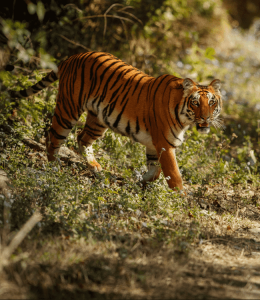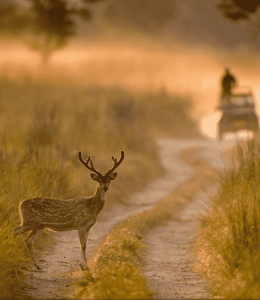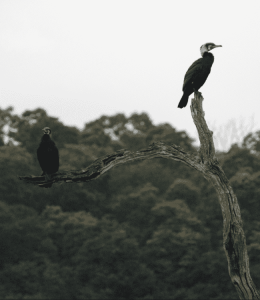- Home
- /
- Best Tiger Safari in...
If you’re planning a Tiger Safari in India, you’re in for an incredible adventure. India has the largest population of wild tigers in the world, making it the perfect destination for wildlife enthusiasts. There are 53 tiger reserves in India where you can see tigers in their natural habitat. Each Tiger Safari in India offers a rare chance to witness the elusive Bengal tiger in the wild. Every tiger reserve is unique, with diverse landscapes and rich wildlife experiences, most nestled within dense forests.
A Tiger Safari in India provides a thrilling experience because tigers are one of the world’s most iconic animals. In addition, it plays a crucial role in supporting ongoing conservation efforts.
Top Most Tiger Safari Destinations in India
India is known as a premier destination for tiger safaris. Here is the top tiger safari destination in India-
Explore the top Tiger Safari destinations in India, including Ranthambore, Jim Corbett, Bandhavgarh, Kanha, and many more. These iconic reserves offer the best chance to spot Bengal tigers in their natural habitat, surrounded by diverse wildlife and breathtaking landscapes.
Sundarban National Park, West Bengal
Sundarbans National Park is located in West Bengal’s Sundarbans mangrove forest. It is the premier destination of tiger safaris and is spread over 1330 sq km. It is known for its mangrove forests and high tiger density. India’s diverse landscapes and dense forest of Bengal set an ideal setting for tiger reserves and national parks. It will be a unique experience for those eager to witness these magnificent creatures in the wild.
Best Time to Visit
If you want to visit Sunderbans National Park, which is part of the UNESCO World Heritage Site, then winter is the best time. You can plan your tiger safari in Sundarbans National Park from November to February. It is the ideal weather for the tiger. In addition, the weather is also comfortable for exploring the mangrove forests by boat.
During the summer season, water level drops, and Royal Bengal tigers also do not roam around. Although, Sunderbans National Park remains open year-round, winter is the perfect month to explore wildlife sanctuaries.

Nearest Airport
Netaji Subhas Chandra Bose International Airport, Kolkata, is the nearest airport. This Airport is about 100 km away from the Sundarban Reserve Park. You can take a cab or taxi from the airport, it will take 30-25 minutes to reach the location.
Nearest Railway Station:
Canning Railway Station is the nearest railway station to park. It is about 29 km away from the Sundarban Park.
Special Things at Sundarban Tiger Reserve: Sundarban Tiger Reserve is one of the tiger conservation sanctuaries in India. here is the list of special things in it-
1. Mangrove Habitat: It is located in the largest Mangrove forest. It provides a unique experience of wildlife, particularly the Bengal tiger.
2. Royal Bengal Tiger: It is home to royal Bengal tigers. Visitors can enjoy the tigers’ unique adaptation to swimming in the water bodies.
3. Boat Safaris: Sundarban also offers boat safaris, which is the most unique tiger reserve in India.
4. Biodiversity Hotspot: Tigers are a key attraction of Sundarban, but there is a diverse range of wildlife like saltwater crocodiles, and bird species. There is a kind of flora and fauna.
Why Sundarban Wildlife Tourism is a Must-Visit:
– Unique Mangrove Ecosystem: Sundarbans is not just about tigers; it’s also a UNESCO World Heritage Site due to its outstanding mangrove ecosystem.
Learn about the crucial role mangroves play in preserving the coastal environment.
– Birdwatcher’s Paradise: Beyond tigers, Sundarbans is a haven for birdwatchers. Discover some of the exotic and rare bird species that call this region home, making it a must-visit for ornithologists and wildlife photographers.
The Thrill of a Sundarban Tiger Safari:
– Expert Naturalist Guides: Get insights into how expert naturalist guides accompany visitors on their tiger safaris, sharing their knowledge about the unique flora and fauna of the Sundarbans.
– Safety Measures: Understand the importance of safety measures during a tiger safari in this wild terrain and how trained professionals ensure visitors’ well-being.
Ranthambore National Park, Rajasthan

When planning your next adventure, consider the thrill of a Tiger Safari in India at Ranthambore National Park, one of India’s most famous tiger reserves. Renowned for its high tiger sightings, this park offers a unique opportunity to witness these majestic creatures in their natural habitat.
Ranthambore National Park is India’s world-famous tiger reserve, situated in the Ranthambore. It is known for high tiger sightings. It features an ancient fort with a rich wildlife experience. It is spread over 392 sq km. Tiger safari, jeep safari, and canter safaris are popular.
Best Time to Visit
To visit Ranthambore National Park, the best time is October to April. During this time, the weather is pleasant for animals as well as for visitors.
Nearest Airport
Jaipur International Airport, Jaipur, is the nearest airport. It is approximately 180 km away from the Ranthambore National Park. You can take a cab or taxi from the airport, it will take 45-50 minutes to reach the location.
Nearest Railway Station
Sawai Madhopur Railway Station is the nearest railway station to park. It is approximately 10 km away from the Ranthambore National Park. Sawai Madhopur Railway Station is accessible to all metro cities.
Bandhavgarh National Park, Madhya Pradesh
Bandhavgarh National Park is renowned for its high Bengal tiger density, making it one of the premier destinations for a Tiger Safari in India. This park offers an exceptional opportunity to experience close encounters with these majestic creatures in their natural habitat. Spread over approximately 527 sq km, Bandhavgarh National Park is not only famous for its tigers but also for its stunning scenic landscapes.
Situated along the banks of the Bamhabi River, the park features the historic Bandhavgarh Fort, adding a touch of cultural heritage to your wildlife adventure.
Best Time to Visit
To visit Bandhavgarh National Park, the right time is October and June. For tiger sightseeing in Bandhavgarh Park, April to June is favorable.

Nearest Airport
Jabalpur Airport, is the nearest airport. It is approximately 200 km away from the Bandhavgarh National Park. You can take a cab or taxi from the airport, it will take 1 hour or more to reach the location.
Nearest Railway Station
Umaria Railway Station is the nearest railway station to the park. Umaria Railway Station is approximately 32 km away from the entrance of Bandhavgarh National Park. Umaria Railway Station is well-connected to all major cities.
Jim Corbett National Park, Uttarakhand

Jim Corbett National Park or Jim Corbett Park is one of the oldest national parks in India. It was established in 1926 and spread about 520 sq km. It is known for its scenic beauty and a substantial tiger population. It offers a traditional safari experience. It offers stunning views of rivers, hills, and forests.
Best Time To Visit
To visit Jim Corbett National Park, the best time is November to June. However, it is open all year. But for wildlife sightings, it is perfect for March to June.
Nearest Airport
Pantnagar Airport is the nearest airport. It is approximately 85 km away from the Jim Corbett National Park. You can take a cab or taxi from the airport to reach the location.
Nearest Railway Station
Ramnagar Railway Station is the nearest railway station to park. It is approximately 12 km away from the Jim Corbett National Park. Ramnagar Railway Station is well-connected to all major cities.
Kanha National Park, Madhya Pradesh
Kanha National Park is a well-maintained tiger reserve in India. Do you know, that Kanha National Park is based on Rudyard Kipling’s “The Jungle Book”? This part is spread over 940 sq km and is known for having a healthy tiger population. Except for tigers, it has barasingha (swamp deer), leopards, and wild dogs.
Best Time To Visit
Kanha National Park, is open from October to June. But for wildlife sightings, it is best to visit from March to June.

Nearest Airport
Jabalpur Airport is the nearest airport. It is approximately 160 km away from the Kanha National Park. You can take a cab or taxi from the airport to reach the location.
Nearest Railway Station
Gondia Railway Station is the nearest railway station to the park. It is approximately 145 km away from the Kanha National Park. Gondia Railway Station is well-connected to all major cities.
Pench National Park, Madhya Pradesh

Pench National Park is an attraction in Madhya Pradesh. It is spread over 756 sq km. This part is also famous for its connection to Rudyard Kipling’s “The Jungle Book”. It is home to wild tigers, leopards, wild dogs, and many bird species. It is covered with forests, rivers, and grassland.
Best Time to Visit
To visit Pench National Park, the best time is October and June. The weather is cooler and comfortable for animals as well as visitors.
Nearest Airport
Dr. Babasaheb Ambedkar International Airport is the nearest airport to the Pench National Park. It is approximately 130 km away from the Pench National Park. You can take a cab or taxi from the airport to reach the location.
Nearest Railway Station
Seoni Railway Station is the nearest railway station to the park, located approximately 30 km from Pench National Park. This station is well-connected to all major cities, making it a convenient starting point for those heading to the Tiger Safari in India offered by the park.
Periyar Wildlife Sanctuary, Kerala
Periyar Wildlife Sanctuary is part of Periyar Tiger Reserve. It is known for the Bengal tiger, elephant, deer, and many more. Periyar Sanctuary is spread over about 925 square kilometers. Periyar Wildlife Sanctuary, Kerala. Periyar Wildlife Sanctuary also offers types of safari options due to Periyar Lake.
Best Time to Visit
To visit Periyar Wildlife Sanctuary, the best time is October to April. During this time, the weather is pleasant. Travelers and visitors can experience boat safaris or wildlife sightings in the park.

Nearest Airport
To Periyar Wildlife, Cochin International Airport is the nearest airport. It is approximately 140 km away from the Periyar Wildlife Sanctuary. You can take a cab or taxi from the airport to reach the location.
Nearest Railway Station
Kottayam Railway Station is the nearest railway station to the park. It is approximately 110 km away from the Periyar Wildlife Sanctuary. Kottayam Railway Station is well-connected to all major cities.
Select the Best Tiger Safari Package
Selecting the best and right tiger safari package enhances the experience of exploring wildlife. Sundarban Wildlife provides different types of packages. You can choose as per your comfort. Our packages include kinds of Safari, accommodation, and additional activities to enhance the adventure.
Types of Safaris Available
At Sundarban Wildlife Reserve, there are various types of safaris available like-
- Jeep Safari: Jeep safari is the most common and popular way to explore the tiger. Jeep Safari is the most comfortable and flexible for enjoying wildlife.
- Canter Safaris: Canter Safari is ideal for groups of people. It is an open safari, the same as jeep safaris. With Canter Safari, you can explore tiger wildlife with your friends and families.
- Elephant Safaris: We have an elephant safari too. It is the most unique safari we offer. Elephant Safari provides you with a unique vantage point to explore the forest from the back of the elephant. It can be a unique safari experience for you.
- Boat Safari: Sundarban also provides a boasting safari for a different experience. You can explore waterways and spot wildlife in the mangroves.
- Walking Safaris: Enjoy a walking safari with a guide and team. Exploring the forest on foot is a unique way to explore the forest.
The Best Seasons for Tiger Safaris in India
If you want to experience tiger safari in India, here is the best time for tiger safaris in India-
- Winter (October to February): Winter is pleasant weather for tigers. Tigers are more active during the winter. October to February is the ideal month to see tigers on the road, patrolling, etc. In addition, other animals can also be spotted near water bodies.
- Summer (March to May): During the summer season, March to May is considerably good to see tigers. Heat draws tigers to waterholes, making them easier to spot. In addition, this time is preferable for professional photographers to shoot the tigers because tigers do not move much in the hot weather.
- Monsoon (July to September): Monsoon is the ideal time to visit the tiger reserve. However, July to September is considerably the best time for tiger safari in the monsoon. Moreover, most parks are even closed during the monsoon season, if it is open you can visit. Due to heavy rains and breeding season, tigers are not seen.
Why Choose Sundarban Wildlife Tourism for a Tiger Safari in India
Our visitors continually praised the thrilling experiences and professional services we offer at Sundarban Wildlife Reserve. We have guided wildlife sightings, well-maintained facilities, and comfortable accommodations, which are most praised by the visitors. Our personal attention adds unique insights into the local ecosystem of flora and fauna with tiger reserves. Sundarban is committed to safety, and conservation, and provides an unforgettable adventure for visitors, which makes us a top choice for wildlife experience in India. Take a look at what our happy and satisfied visitors say about us –
FAQs for Tiger Safari in India
What wildlife can I see in the Sundarban Tiger Reserve?
Sundarban Tiger Reserve is known for Bengal tigers as well as saltwater crocodiles, several bird species, rich mangrove flora, and many more.
What is the best time to see a tiger in Sundarban Tiger Reserve?
If you don’t want to miss the chances of tiger sightseeing, then visit Sundarban Tiger Reserve from November to March.
Where are the best places for a Tiger Safari in India?
Sundarbans Tiger Reserve is the best place for a tiger safari in all of India.
How can I reach the Sundarban Tiger Reserve?
Sundarban Tiger Reserve is situated at a prime location. You can reach Sundarban by air, road, or train.
Do you have accommodation available?
Yes, we have accommodation too for the visitor to spend time in the wildlife. We have different packages.
Is it safe to visit Sundarban Tiger Reserve with kids?
Yes, it is safe to visit Sundarban Tiger Reserve with kids. We make sure all are safe and protected for the visitors.
Can I spot a tiger in Sundarban Tiger Reserve?
Yes, Sundarban Tiger Reserve is known for tiger safaris. Our guide will help you to spot the tiger in the dense mangrove forests.
What is the entry fee for Sundarban Tiger Park?
The entry fee varies from time to time. It is good to contact us for an exact fee. In addition, we have packages of different ranges.
What should I pack to visit Sundarban Tiger Reserve?
If you are coming to Sundarban Tiger Reserve, pack comfortable clothes, shoes, insect repellent, sun protection, and a camera.
How can I book a tiger safari in Sundarban Tiger Reserve?
If you want to book a tiger safari with Sundarban Park, book from the website or reach out to our customer support.
Do I need a special permit to visit Sundarban Tiger Reserve?
No, there is no special permit required to visit Sundarban Tiger Reserve. You just need to book your tickets for a safari or stay.
Can I visit the Sundarban Tiger Reserve alone?
Yes, you can visit Sundarban Tiger Reserve alone too. During the tiger safari, our professional guide is always with you. Remember, we do not allow Safari alone.
Is there any local custom that I need to be aware of?
There is no specific customer that you need to be aware of. But, respect the local customers and local people when you visit West Bengal.
What is the average time for a Sundarban tiger safari?
Safaris typically last between 3 to 4 hours. In addition, it also varies with the weather or conditions.
